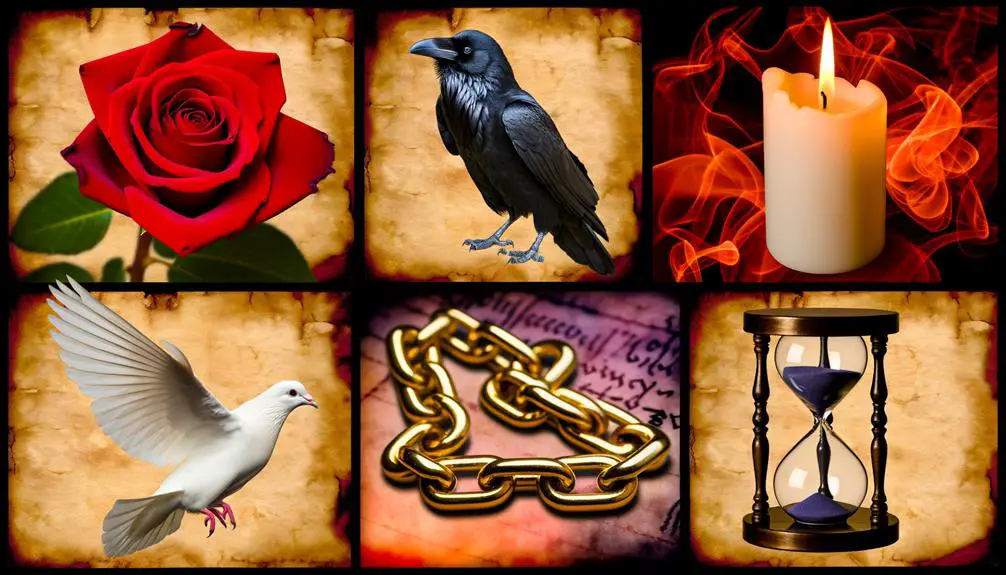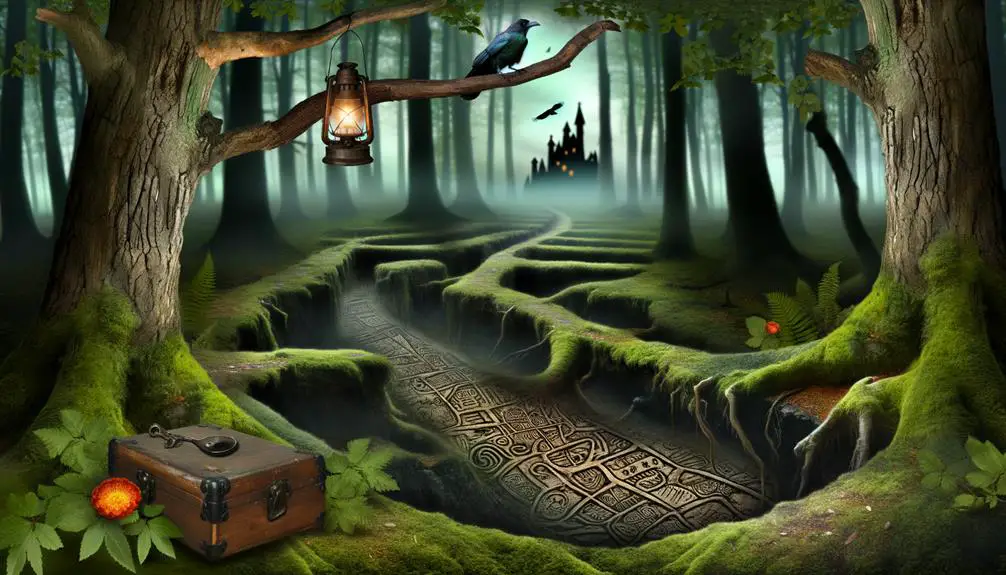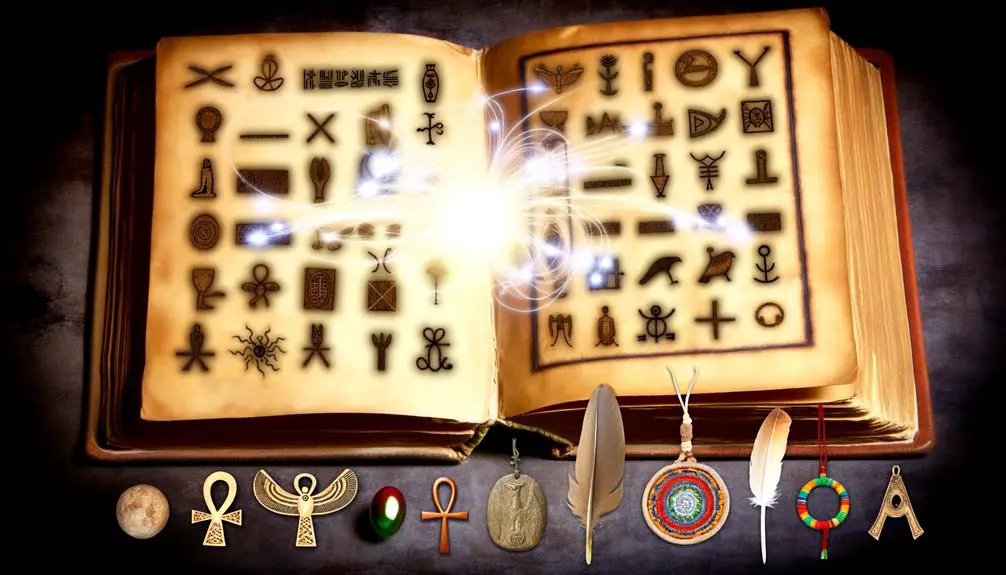What Is the Meaning of Symbolism in English Literature?
Symbols in English literature serve as multifaceted devices that communicate profound themes, emotions, and cultural nuances. Common literary symbols such as the rose or the raven carry layered meanings, often reflecting societal values and historical contexts.
In classic novels, symbols like the green light in "The Great Gatsby" or the scarlet letter 'A' in Hawthorne's work resonate with philosophical and moral questions. Understanding these symbols involves analyzing the cultural and historical backdrop, authorial intent, and character development.
These elements combine to offer richer, more insightful narrative experiences, inviting deeper exploration into the text's underlying meaning and significance.

Key Takeaways
- Symbols in literature convey deeper themes, emotions, and narratives.
- Cultural and historical contexts shape the interpretation of literary symbols.
- Classic novels use symbols to pose philosophical and moral questions.
- Symbols reflect character development and internal struggles.
- Understanding an author's background enriches symbol analysis.
Common Literary Symbols

Numerous literary symbols recur across various works of English literature, serving as profound tools for conveying complex themes and emotions. Common symbols like the rose, often representing love or beauty, and the raven, symbolizing death or ill-omen, transcend individual texts to create a shared cultural lexicon.
Water frequently symbolizes purification or transformation, while darkness often denotes mystery or evil. These symbols, through their repetition and layering, enhance readers' interpretative experience by providing deeper meaning and resonance.
Symbolism in Classic Novels
Building upon the understanding of common literary symbols, classic novels provide rich and nuanced examples where symbolism is intricately woven into the narrative fabric to illuminate themes and character development.
In Nathaniel Hawthorne's 'The Scarlet Letter,' the letter 'A' evolves from a mark of shame to a symbol of identity and resilience.
Similarly, F. Scott Fitzgerald's 'The Great Gatsby' employs the green light as a multifaceted symbol representing Gatsby's unattainable dreams and the broader theme of the American Dream.
In Herman Melville's 'Moby-Dick,' the white whale symbolizes the elusive and destructive nature of obsession.
These symbols are not mere decorative elements; they are essential to understanding the deeper philosophical and moral questions the novels pose, enriching the reader's engagement with the text.
Interpreting Symbolic Imagery

Interpreting symbolic imagery in literature requires a nuanced understanding of the cultural, historical, and contextual factors that imbue these symbols with meaning. Symbols are not merely decorative elements; they encapsulate deeper narratives and truths. For instance, a rose may signify love or passion, but can also represent secrecy or martyrdom, depending on its context.
| Symbol | Common Interpretation |
|---|---|
| Rose | Love, Passion |
| Dove | Peace, Purity |
| Raven | Death, Omen |
| Mirror | Truth, Self-reflection |
Understanding these symbols necessitates an analytical approach, considering the period in which the work was written and the author's background. Hence, the interpretation of symbolic imagery is an intricate process that enriches the reader's comprehension and appreciation of literature.
Symbolism and Character Development
Symbolism plays an essential role in character development, often revealing deeper layers of a character's psyche and motivations. Through carefully chosen symbols, authors can subtly convey complex aspects of a character's identity and inner conflicts.
For instance, a recurring object or motif associated with a character can illuminate:
- Internal Struggles: The use of symbols to reflect a character's internal battles or moral dilemmas.
- Emotional States: Symbolic items or settings that mirror a character's emotional landscape.
- Transformation: Objects that signify personal growth or changes in the character's journey.
- Relationships: Symbols that elucidate the dynamics between characters, revealing hidden tensions or bonds.
Such symbolic elements serve as a nuanced tool for enriching narrative depth and fostering a profound connection between the reader and the characters.
Cultural Influence on Symbols

Cultural context profoundly shapes the interpretation and significance of symbols in English literature, influencing how readers perceive and understand thematic elements.
Symbols often derive their meanings from the prevailing cultural milieu, making them susceptible to shifts in societal norms and values.
For instance, the serpent in Western literature commonly symbolizes evil, stemming from Judeo-Christian traditions, whereas in other cultures, it may represent wisdom or renewal.
Recognizing these cultural underpinnings allows readers to grasp deeper layers of meaning and appreciate the diversity of interpretive possibilities.
Consequently, an awareness of cultural influences enriches literary analysis, facilitating a more nuanced comprehension of how symbols operate within specific historical and social frameworks.
This underscores the intricate interplay between literature and the cultural landscapes it inhabits.
Conclusion
In summation, literary symbols serve as the intricate threads weaving together the rich tapestry of meaning within texts.
These symbols, whether emerging from classic novels or cultural contexts, offer profound insights into character development and thematic depth.
Interpreting symbolic imagery is akin to revealing layers of understanding that transcend the superficial narrative, like discovering a hidden treasure chest.
Therefore, symbolism remains an indispensable tool in the world of English literature, enhancing the interpretative experience and enriching the reader's journey.





